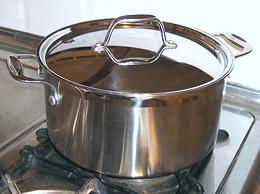
Stock is one of the very most important staples you can have in your kitchen, useful for many recipes from many cultures. Unfortunately, in most kitchens, it is often routinely unavailable and inconvenient to make when needed. You can, of course, resort to commercial bouillon cubes or similar, if the list of ingredients doesn't scare you. Tropical Cultures without refrigeration traditionally used fermented flavorings, but have mostly converted to commercial cubes and powders. The methods presented here will help avoid that necessity, particularly in the matters of storage and availability.
What is the difference between Stock and Broth? Not a lot, really. Broth is usually defined as the liquid left from simmering a bird or a large piece of meat to be served separately. Stock is purpose made from off-cuts, bones and scraps of birds fish or meats. Either may be made with herbs, vegetables and spices - or not.
This is the most serious problem in having stock available. Writers warn that you can keep stock in the refrigerator for just a few days (true, as far as that goes). This is fine if you are constantly at work in the kitchen cooking similar things that use stock. For most of us, that isn't nearly long enough. Our lives simply are not that orderly.
Many suggest pouring stock into ice cube trays, freezing, then bagging the cubes for future use. Problem: the packing density of cubes is very poor, and your freezer compartment is probably already full. Years ago, I would freeze stock in the bottom of a saucepan, dip the pan in hot water to release the cookie and wrap it in plastic. A piece of the cookie could be chopped off when needed. Much better, but still a freezer space and accessability problem, especially with multiple kinds of stock.
How long will this stock keep in the refrigerator? I don't know, I discard any that is approaching a year old - haven't encountered a bad jar yet (one sniff would tell you if it was bad). Of course, if you find a jar where the lid isn't sucked down tight and has some spring to it, it should be discarded.
When you use some, you pry up the edge of the lid to break the seal so you can get the lid off easily (I use an antique Lucky Lager church key - most church keys sold today are too thick), but some recommend the pointy end of a spoon. If you have some left it must be used within a few days or reboiled and stored in a smaller jar.
Most recipes presume you will make the necessary stock specifically for that recipe, just before using it. That isn't really practical, particularly if you are a "non planner" like I am. You make your stock when convenient. Store it as described above and it will be ready, even months later.
I usually make my stock at least a little overly strong so it stores in less space - you can always add some water later.
Herbs & Vegetables: While most stock recipes specify various vegetables, herbs, salt, spices, etc. in the making of the stock, I usually use only the meats. The reason is simple. I seldom know in advance what recipe or even what ethnicity I'll be using that stock for - especially since it may not be used for months. Those additional flavorings are very easy to add at the time you use the stock. If you do include Herbs and Vegetables, and don't have a specific recipe to guide you, use a mix similar to that for Vegetable Stock, but perhaps half as much.
Put the meat and bones in the stock pot and cover with water by an inch or two, depending. The stock pot should be brought to a boil quickly. Use a flat skimmer to skim off any sludge that rises to the top as the pot comes to a boil. Turn down and simmer slowly. The slower it simmers the clearer the finished stock will be.
The Chinese, to make the very clear stocks they often demand, cook the stock in a double boiler. With the outside pot at a simmer, the inside pot stays just a few degrees below a simmer.
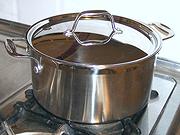
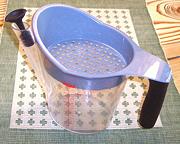
The only deficiency of this device is the lack of any tool for cleaning the inside of the spout - and I'm pretty fussy about that sort of thing. I purchased a cheap bulb baster which came with a cleaning brush that works just fine in the spout.
Wet the plug and put it in before filling the separator. Let it sit
for a bit for the fat to rise to the top, then pull the plug and decant
about 2/3 of the contents. Re-plug and refill. Let sit, then decant again.
For the last batch, pour slowly, watching the spout. Tilt up to stop flow
the moment you see a bubble of fat enter the spout. Store the plug inside
the bowl, not stuck in the spout, or it eventually won't seal well.
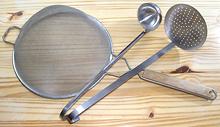
Since this photo was taken, I've supplemented this collection with
a large and a small Asian skimmer / strainer with extremely fine mesh.
The small one is good for skimming when the pot is too small for the
flat skimmer. Pouring into the gravy separator through the large one
results in cleaner stock.
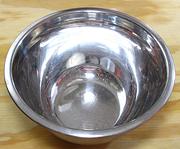
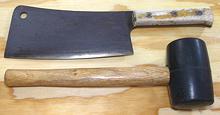
One of the stupidest pieces of knife advice I've seen is that "a meat
cleaver does not need to be sharp". It needs to be very sharp, or it will
skid off the bones sending them flying rather than bite in and crack
them. It is sharpened at a steeper angle so the edge is very
sturdy, but it is still sharp.
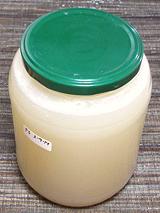
Jars from most commercial canned goods, such as sauerkraut, pickles
and the like are made of heat resistant glass and will not crack when
hot stock is poured in, though I give the stock a couple of minutes
to cool below boiling. The only time I remember a cracked jar was some
years back with an old Clausen's sauerkraut jar (but the stock was
saved - it just cracked, and any glass chips would quickly sink to the
bottom).
When I need chicken meat, I buy bone-in, skin-on, thighs (usually), or leg quarters - whichever seems most reasonable at the time (leg quarters produce more broth, less meat). I skin the meat, trim the fat, cut out the bones, and use the meat immediate or freeze it in a single layer to minimize damage from water crystals. All the bones, skins, off-cuts, and fat go into the stock pot. Yes, the fat too - much of the desirable flavor from fat is water soluble, and the fat is easy to remove later with your gravy separator.
For recipes calling for cooked chicken, I put the whole Thighs in a pot, skin, bones, and all, bring to a boil, then simmer for about 30 minutes until Chicken is tender. I fish them out, let cool, then remove bones and skin. The skin and bones go back in the pot to simmer another hour or so to strengthen the stock. 4 pounds of bone-in, skin-on thighs yields about 1 pound 14 ounces of cooked meat after skinning and boning.
Chicken bones, skin and fat should be brought to a boil with skimming as described in General Notes, then simmered slowly for 1 to 2 hours. If you use herbs and vegetables, put them in for the last 45 minutes or so. Strain, defat and store as described above.
A Caution: many years ago I was doing computer programming rather than cooking. On Monday I'd buy a big tray of chicken legs, toss them in a pot, simmer until done, then eat as many as I wanted. I'd strip the meat off the rest, and let the skins and bones simmer overnight for a very strong soup stock. Then several days during the week I'd use the stock and chicken meat with a little vegetables for chicken soup. The result was painful episodes of gout. Once I determined the source of the problem, I've used chicken more moderately and have had no problems at all (treat gout with celery seed extract, it's cheap and effective - used it on my last episode many years ago).
When I need Beef or Pork, I buy a big cut, bone in, and in the case of pork, often with skin and fat on. I cut these up for the meat I need and everything else goes in the pot, including fat, just as for chicken. I usually buy more than I need right then and freeze the rest. My tests find frozen meat loses no more liquid than non-frozen during cooking, it just loses it a bit faster.
Yes, more of a hassle than buying trimmed cuts, but you get all that really great soup stock this way.
If your off-cuts aren't sufficient for a pot of stock, freeze them to add to the next batch, or better, buy some meaty beef bones at the same time so you have enough - they're usually not too expensive. If practical, larger bones should be broken up - see Cleaver & Mallet under Equipment above.
Bring to a boil with skimming as described in General Notes. Simmer slowly for an absolute minimum of 4 hours, but 7 hours or so is much better. If you use vegetables and herbs, put them in for the last 45 minutes or so. Strain, defat and store as described above.
This is pretty much the same as the White Stock above, but first preheat the oven to 475°F/250°C and roast meat and bones in a roasting pan, turning several times, until well browned, but not at all blackened. This may take around an hour. From there, proceed as above.
Buy whole fish from a reliable fish market. Here in Los Angeles we have a large number of very good Asian fish markets to select from. Frozen is OK (today just about all fish is frozen or "previously frozen"). Actually, whole fish is about the only way to be sure you're getting what you're paying for - especially in the more costly fish. "Substitution" is rampant in the fish market, and even in pricey sushi bars. Of course some fillets, like tilapia, are unmistakable, and I buy some for convenience, but I often want skin-on and/or to make stock where only whole tilapia will do.
Select fish that makes good stock of the type you want - fish isn't as simple as chicken or mammals. For suitable types see the "Details and Cooking" links from the various types of fish listed on our Varieties of Fish page (very large page). For pictorial instructions on how to prepare fish for stock, see our Making Fish Stock page. Shrimp shells can be added along with the fish for a more complex flavor.
Bring to a boil with the usual skimming as described in General Notes, and simmer for about 40 minutes, at least 30 and no more than 45 minutes. If vegetables and herbs are used, they go in with the fish. Strain, defat, and store as described above.
Here you have no choice whatever except to include the herbs and vegetables, or you will have naught but hot water. The recipe given here is a good basic stock. You can experiment with many other vegetables, but use a little caution - don't overload with a flavor you are not familiar with, and be cautious with Bell Peppers and Tomatoes, vegetables that tend to "take over". Some people use Onions, but Leeks make a more pleasant stock.
Remember, if you're serving vegan, you must be certain no animal was inconvenienced in any way in producing, delivering, or preparing the vegetables used (including packaging). Inconveniencing people (even though we are also animals) is not only permitted, but mandatory in the vegan lifestyle. This recipe makes 8 cups.
|
|
10
5 5 8 8 2 6 8 8 1 10 1 |
oz
oz oz oz cl T c t |
Leeks
Celery Carrots Scallions Garlic Bay Leaf Thyme sprigs Parsley sprigs Peppercorns Olive Oil ExtV Water Salt |
|